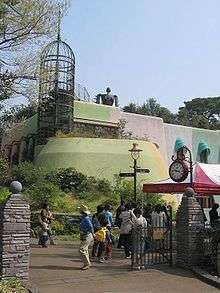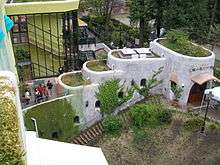Ghibli Museum
 | |
| Established | October 1, 2001 |
|---|---|
| Location |
1-1-83 Shimorenjaku, Mitaka Tokyo 181-0013 |
| Website | www.ghibli-museum.jp |
The Ghibli Museum (三鷹の森ジブリ美術館 Mitaka no Mori Jiburi Bijutsukan, Mitaka Forest Ghibli Museum) is a museum showcasing the work of the Japanese animation studio Studio Ghibli. It is located in Inokashira Park in Mitaka, a western city of Tokyo, Japan. The museum combines features of a children's museum, technology museum, and a fine arts museum, and is dedicated to the art and technique of animation. Some features include a replica of the Catbus from My Neighbor Totoro (1988), a café, bookstore, rooftop garden, and a theater for exclusive short films by Studio Ghibli.
History

Planning for the museum began in 1998. Construction started in March 2000, and the museum opened October 1, 2001.[1] Studio Ghibli director Hayao Miyazaki designed the museum himself, using storyboards similar to the ones he creates for his films. The design was influenced by European architecture such as the hilltop village of Calcata in Italy. The museum features internal and external spiral staircases built from iron, interior bridges, and balconies stretching throughout the building's height. These stairways lead to exhibits, dead ends, and across bridges.[2] These characteristics are meant to reflect Miyazaki's building designs displayed in his film work.[3] Miyazaki's aim was to make the building itself part of the exhibit,[4] and for the museum to be an uplifting and relaxing experience "that makes you feel more enriched when you leave than when you entered". The museum is described as a "portal to a storybook world." [3] Hayao Miyazaki's goal was also for people to experience the museum with their own eyes and ears. "Let's get lost together" is the museum's slogan, derived from Hayao Miyazaki's vision for visitors to immerse themselves in his imagination and film work.[3][5]
Exhibits
Permanent exhibitions
On the bottom floor is an exhibit room showing the history and science of animation, including a three-dimensional zoetrope named "Bouncing Totoro", with models of characters from My Neighbor Totoro (1988).[6] On the first floor is a mock-up of an animation studio. Called "Where a Film is Born," the five-room exhibit is meant to showcase the creative process of an animation filmmaker such as illustration techniques.[2] Packed with books and toys, the room also displays drawings and illustrations that cover the walls.[3] Another exhibit demonstrates the process of creating an animated film, with sketches, storyboarding, keyframing, cleanup, coloring and background painting.
Special exhibitions
In addition to Ghibli-oriented exhibitions, the museum hosts an area showcasing work from other studios.
| Date | Exhibit |
|---|---|
| 2001–2002 | Spirited Away |
| 2002–2004 | Castle in the Sky and Imaginary Flying Machines |
| 2003–2004 | Works by the Russian animator Yuri Norstein |
| 2004–2005 | Pixar Animation Studios |
| 2005–2006 | Heidi, Girl of the Alps |
| 2006–2007 | Aardman Studios, primarily focused on their work on Wallace and Gromit. |
| 2007–2008 | Goldilocks and The Three Bears (3びきのくま Sanbiki no kuma), based on a picture book version by Leo Tolstoy. Panda! Go, Panda!, one of Miyazaki's and Isao Takahata's early, pre-Ghibli films from 1972.[7] |
| 2008–2009 | Petit Louvre[8] |
| 2009–2010 | Ponyo on the Cliff by the Sea[9] |
| 2010–2011 | Ghibli Forest Movies — Welcome to Saturn Theater[10] |
| 2011–2012 | The View from the Cat Bus[11][12] |
| 2012–2013 | The Gift of Illustrations ― A Source of Popular Culture[13][14] |
| 2013–2014 | The Lens at Work in The Ghibli Forest[15] |
| 2014–2015 | The Nutcracker and the Mouse King ― A Fairy Tale Treasure[3] |
| 2015–2016 | The Haunted Tower ― Perfect Popular Culture[3][16] |
Short films
The Ghibli Museum shows several short films exclusive to the Ghibli museum. Located in the basement of the museum is The Saturn Theater.[3] The theater has windows where automated shades lower and open before and after each showing of its short films. This is because Hayao Miyazaki designed the theater with small children in mind, who could possibly be scared of the closed in theater.[17] The museum shows one of the following Ghibli short-films in the Saturn Theatre:[18]
- Koro's Big Walk (コロの大さんぽ Koro no dai-sampo)
- Water Spider Monmon (水グモもんもん Mizugumo Monmon)
- Mei and the Kittenbus (めいとこねこバス Mei to Konekobasu)
- The Day I Harvested a Star (星をかった日 Hoshi o Katta Hi)
- The Whale Hunt (くじらとり Kujiratori)
- Looking for a home (やどさがし Yadosagashi)
- A Sumo Wrestler's Tail (ちゅうずもう Chūzumō)
- Mr. Dough and the Egg Princess (パン種とタマゴ姫 Pan dane to tamago hime)
- Treasure Hunting (たからさがし Takara Sagashi)
- Boro the Catepillar (Kemushi no Boro)
Each guest to the museum is only permitted to watch the short film once during a single visit.
Other features
Tri Hawks
Tri Hawks is a reading room and bookstore in the Ghibli Museum. Opened on February 6, 2002, it is filled with books recommended by Hayao Miyazaki. "Mi-taka," the city where the Ghibli Museum is located, means three hawks. The name Tri Hawks comes from a pun based on the city's name.[3][19]
Mamma Aiuto
Mamma Aiuto, on the top of the Ghibli Museum, is the souvenir gift shop named after the band of sky pirates in the movie Porco Rosso.[20] The name Mamma Aiuto translates to "mama, help me" in Italian, which was where Porco Rosso was set.[3] Among other items, it sells classic and non-Japanese animation movies under the eponymous Ghibli Museum Library label.
Straw Hat Café
The Straw Hat Café is the Ghibli Museum's only sit-down restaurant. It was created with the help of a housewife who is a mother of four; Miyazaki wanted the café's food to be "a kind of home cooking". [21] The Café serves hot and cold foods, snacks, and desserts.[3] Sold at the takeout section is an original alcoholic beverage: "Valley of the Wind" beer. The beer was created by a collaboration with Dairy Kingdom Oratche, a microbrewery in Tanna Basin. The beverage's label was hand drawn by Gorō Miyazaki, Hayao Miyazaki's son, who is an animation director at Studio Ghibli as well.[22]
Catbus Room
There is a playroom for children age 12 and below with a giant Catbus toy to play in. In order for the Catbus to fit in the museum it had to be downsized from the original film scale as seen in My Neighbor Totoro (1988).[3]
Rooftop Garden
On the museum's roof is a garden with a life-size, five meter tall statue of a robot from the final episode of Lupin III Part II and Castle in the Sky.[2][23] The Robot Soldier was made by the artist Kunio Shachimaru.The statue is formed from hammered copper plate and took 2 years to create. The keystone from the movie Castle in the Sky can be found here. The keystone, bearing an inscription in Old Persian cuneiform, is a replica of the control room stone found in the floating castle, Laputa, in the movie Castle in the Sky.[24]
Museum Tickets
Tickets to the Ghibli Museum are only accepted if bought in advance. These reserve tickets can be purchased outside Japan in Hong Kong, Taiwan, Korea, North America, Europe, and Australia. Tickets range from ¥1,000 for adults to ¥700 for ages thirteen to eighteen year olds, ¥400 for ages seven to twelve year olds, and ¥100 for ages four to six year olds. Ages four years old and under are free. At the museum's entry, the reserve tickets are exchanged for a 35mm film strip that features a scene from one of the Studio Ghibli films.[2][3][25][26]
Fresco Painting
At the entrance of the building, the museum's ceiling is covered in a fresco painting. The painting features characters from the Studio Ghibli films such as Kiki on her broomstick from the film Kiki's Delivery Service (1989).[3]
References
- ↑ Miyazaki, Hayao; Isao Takahata (2009). Starting Point 1979–1996. Viz Media. pp. 446–447. ISBN 978-1-4215-0594-7.
- 1 2 3 4 Michael, Bodey. "Studio Ghibli: Celebrating Japanese Animation". theaustralian.com.au. The Australian. Retrieved 4 June 2015.
- 1 2 3 4 5 6 7 8 9 10 11 12 13 Museo d'Arte Ghibli. "The official site of Ghibli Museum, Mitaka in Japan - This is the Kind of Museum I Want to Make!". ghibli-museum.jp. Retrieved 3 June 2015.
- ↑ Isao Takahata, Goro Miyazaki (2005). 宮崎駿とジブリ美術館 (Hayao Miyazaki and Ghibli Museum) (DVD). Japan: BVHE Japan.
- ↑ Huang, Eric. "'The Continuing Allure of Hayao Miyazaki': Celebrating Japanese Pop Culture". The Stanford Daily. The Stanford Daily. Retrieved 6 May 2015.
- ↑ Miyazaki & Kitazawa 2006, p. 54.
- ↑ "ギャラリー展示「パンダコパンダ展」。". www.ghibli-museum.jp (in Japanese). Archived from the original on 2008-02-28. Retrieved 2015-06-02.
- ↑ 企画展示『小さなルーヴル美術館』展 (in Japanese). Archived from the original on 2008-10-27. Retrieved 2015-06-02.
- ↑ 企画展示『崖の上のポニョ展』 (in Japanese). Archived from the original on 2009-04-05. Retrieved 2015-06-02.
- ↑ "Welcome to the Saturn Theater ~ The Ghibli Forest Film Exhibition". www.ghibli-museum.jp. Archived from the original on 2011-02-08. Retrieved 2015-06-02.
- ↑ "The View from the Cat Bus". www.ghibli-museum.jp. Retrieved 2011-12-11.
- ↑ 企画展示『ねこバスから見た風景展』. www.ghibli-museum.jp (in Japanese). Archived from the original on 2011-04-17. Retrieved 2015-06-02.
- ↑ ""The Gift of Illustrations ― A Source of Popular Culture" Exhibition". www.ghibli-museum.jp. Retrieved December 16, 2012.
- ↑ "新企画展示『挿絵が僕らにくれたもの』展". www.ghibli-museum.jp. Archived from the original on 2013-01-16. Retrieved 2015-06-02.
- ↑ "新企画展示のお知らせ 「ジブリの森のレンズ展」". www.ghibli-museum.jp. Retrieved 2013-06-21.
- ↑ Phro, Preston. "Miyazaki-curated Ghibli Museum exhibit of "Ghost Tower" to open at end of May". Rocket News 24. Socio Corporation. Retrieved 7 May 2015.
- ↑ Miyazaki & Kitazawa 2006, pp. 192–193.
- ↑ 映像展示室 土星座 (in Japanese). Retrieved January 7, 2010.
- ↑ Miyazaki & Kitazawa 2006, pp. 146, 266.
- ↑ Miyazaki & Kitazawa 2006, p. 267.
- ↑ Miyazaki & Kitazawa 2006, p. 201.
- ↑ Rodgers, Krista. "For grown-ups only! Ghibli Museum's Straw Hat Cafe is offering "Valley of the Wind" beer". Rocket News 24. Socio Corporation. Retrieved 6 May 2015.
- ↑ Museo d'Arte Ghibli. "The official site of Ghibli Museum, Mitaka in Japan". ghibli-museum.jp. Retrieved 3 June 2015.
- ↑ Miyazaki & Kitazawa 2006, pp. 123.
- ↑ "Ghibli Museum, Mitaka". JTB USA. JTB USA Inc. Retrieved 7 May 2015.
- ↑ "Ghibli Museum". Japan Guide. japan-guide.com. Retrieved 7 May 2015.
Further reading
- Miyazaki, Hayao; Kitazawa, Satoko (2006). Ghibli Museum, Mitaka Catalog, Newly Revised and Enlarged Edition. The Tokuma Memorial Cultural Foundation for Animation. ASIN B005VKJA4G.
External links
| Wikimedia Commons has media related to Ghibli Museum. |
- Official website
- Ghibli Museum Facebook page
- Background information with photographs
- Tutorial: How to buy a ticket for the museum
- Information about some of the short films shown at the museum
- Wikivoyage: Ghibli Museum
Coordinates: 35°41′46.44″N 139°34′13.55″E / 35.6962333°N 139.5704306°E